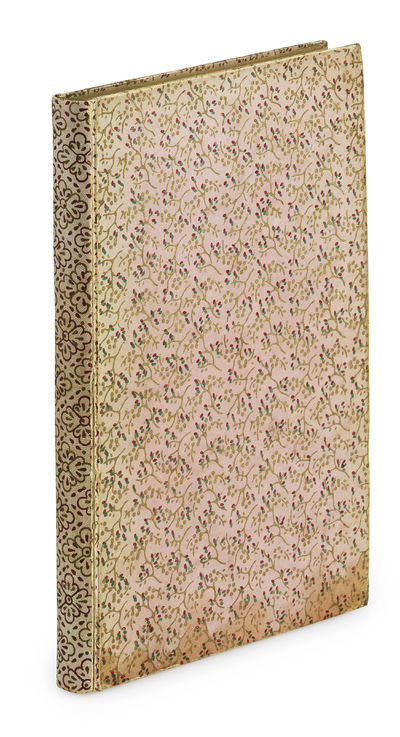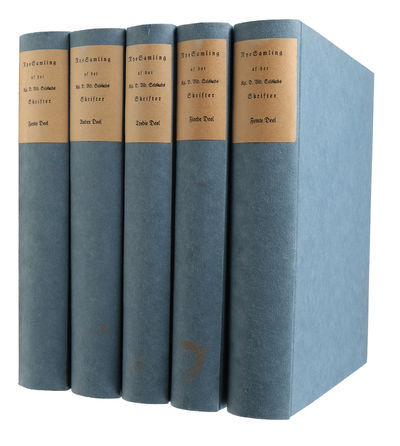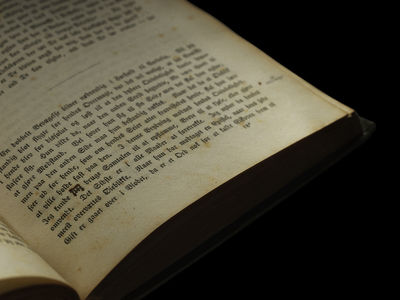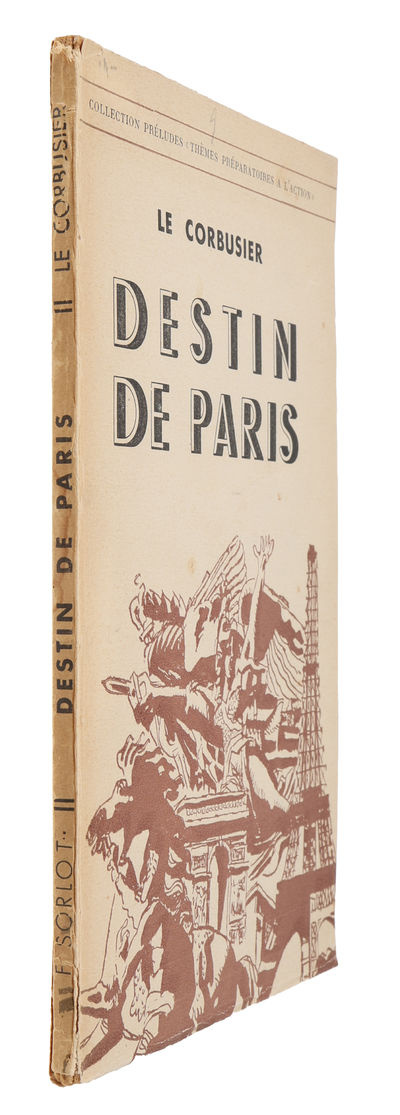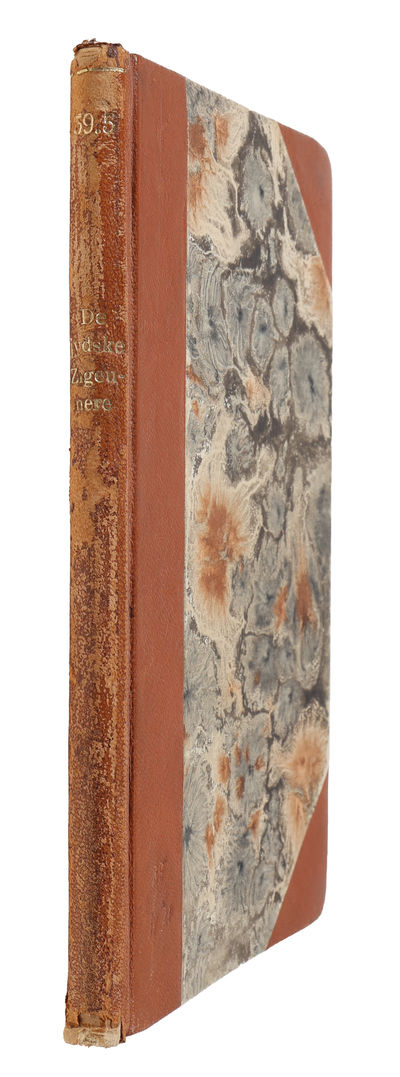KIERKEGAARD, SØREN.
1) A.F. Hvo er Forfatteren af Enten-Eller. 2) Taksigelse til Hr. Professor Heiberg 3) En lille Forklaring 4) En Erklæring og Lidt til [Printed in: Fædrelandet, edt. Giødwad and Ploug]. - [ANTICIPATING MODERN LITERARY THEORY MY MORE THAN A CENTURY]
Herman H. J. Lynge & Søn A/S
lyn62136
(København), 1843-1845. 1) 4de Aarg. Nr. 1162. Mandagen den 27. februar 18432) 4de Aarg. Nr. 1168. Søndagen den 5. Marts 18433) 4de Aarg. Nr. 1236. Tirsdagen den 16. Mai 18434) 6te Aarg. Nr. 1883. Fredagen den 9. Mai 1845 All 4 articles in large 4to (33 x 24,5 cm – 4) measuring 33 x 25). 2 columns to a page. 1) 2 pp. Columns 9325-9332. Kierkegaard’s article: Columns 9330-93322) 2 pp. Columns 9373-9380. Kierkegaard’s article: Columns 9373-93763) 2 pp. Columns 9917-9924. Kierkegaard’s article: Columns 9921-99224) 2 pp. Columns 15089-15096. Kierkegaard’s article: Columns 15093-15096. Marginal dampstaining
A magnificent set of all Kierkegaard’s four articles on his own authorship and pseudonymity, all in the exceedingly scarce original printings of The Fatherland. During its entire existence, The Fatherland would be published in ca 2.000 copies, making it of the utmost scarcity today. Almost all copies of it have been destroyed, thrown out, worn, etc., and it is extremely rare on the market. The issues we have at the moment are the only ones from this period that we have ever seen for sale. Kierkegaard’s play with the pseudonyms is a fundamental part of his authorship. Either-Or is a prime example of how these pseudonyms interact and how they represent different parts of Kierkegaard and his thought. Merely a week after the publication of Either-Or, Kierkgaard publishes an article entitled Who is the Author of Either-Or. The background for the publication is, not surprisingly, the many immediate reactions that followed the publication of his magnum opus. The article was published in The Fatherland on February 27th, 1843 and is the second paper pertaining to Kierkegaard’s pseudonymity and the first paper pertaining to the reception of Either-Or. As we know, Either-Or initiated Kierkegaard’s pseudonymous authorship, and the work caused quite a sensation, not only due to its massive length, which was very unusual at the time, but also due to the interest in the authorship of the work. The article Who is the Author of Either-Or makes use of this interest and is itself also published pseudonymously. At no point does it mention the name Kierkegaard. He states that there is no consensus as to the authorship of the work and even posits various theories on the authorship based on external and internal evidence, finally concluding that the identity of the true author is immaterial. As Kierkegaard owned up to the authorship of Either-Or in Unscientific Concluding Postscript, so he did to that of the present article, admitting there that he is indeed also the A.F. that has authored Who is the Author of Either/Or. When Nielsen collected and published Kierkegaard’s newspaper articles posthumously, in 1857, he apparently was not aware that Kierkegaard was also the author of Who is the Author of Either- Or and did not include it in his publication. Following Who is the Author of Either-Or is another paper on the same subject, printed merely a week after the first, namely on March 5, 1843, also in The Fatherland. It is entitled A Word of Thanks to Professor Heiberg and is also written under a pseudonym. This time the pseudonym is Victor Eremita, who was the pseudonymous name for the editor of Either-Or. This article is written as a reaction to Heiberg’s review of Either-Or and constitutes the second of the four papers that Kierkegaard writes on the immediate reactions to and reception of his magnum opus. Heiberg had written his review of Either-Or, without knowing the identity of the author, in Litterær vintersæd, which was published in Intelligensblade (of which Heiberg himself was the publisher). Some of Heiberg’s criticism consisted in Either-Or being ridiculously long. But the review also clearly shows that Heiberg had not understood the work. Which is exactly what Kierkegaard points out in A Word of Thanks to Professor Heiberg. Hidden under a veil of irony, he nods to the importance of Heiberg’s review, but at the same time pointing out that Heiberg has misunderstood the work and is not susceptible to finer dialectic. A couple of months after the article on Heiberg’s review, namely on May 16, 1843, Kierkegaard publishes his third article on his own authorship, also in The Fatherland. The article is called A Little Explanation and is published under Kierkegaard’s own name. The article is a reaction to the reception of Either-Or, but more specifically a dismissal of the persistent rumors that connected Kierkegaard’s name with it. Although the paper was published on May 16, 1843, Kierkegaard must have finished it no later than May 8, as he left for Berlin that day, only to return on May 30th. In Either-Or, towards the end, there is a sermon, which, according to contemporary rumors in Copenhagen, was so similar to a trial sermon that Kierkegaard had held in the winter semester 1840-41 after having entered the Royal Pastoral Seminary, that people concluded that Kierkegaard must be the author of Either-Or. In the present paper, A Little Explanation, Kierkegaard, in his own name, attempts to explain that the sermon he held in the Winter 1841-42 (possibly misdated in order to confuse the readers further) bears no resemblance to the sermon in Either-Or, adding sarcastically how wonderous it is that someone in the audience has paid so well attention that he was able to recall the sermon more than a year later and adds ridiculous silly logic to the conclusion of the rumor mongers. Thus, by portraying the absurdity in comparing the two sermons, Kierkegaard “proves” how preposterous the notion that he should be the author of Either-Or is. Two years later, on May 9, 1845, also in The Fatherland, Kierkegaard publishes his fourth and final article on his own authorship and pseudonymity. Also published in his own name, this article, entitled An Explanation and a Little More, is a response to a review of his work Three Discourses on Imagined Occasions from 1844, in which the author attributed several of the pseudonymous works to Kierkegaard. Kierkegaard distances himself sharply from the article, which was printed in Berlingske Tidende. In the beginning of this short article, he states the obvious point that “If I am not the author of these books, then the rumor is a falsehood. However, if I am the author, then I am the only one authorized to say that I am so” (column 15094), using sophistic logic to prove that the rumor can only be untrue. Kierkegaard’s pseudonyms not only play a pivotal part in his authorship and his thought in general, they are also part of an endeavour to focus the readers’ minds on the works themselves rather than on the author, freeing them from the person who wrote them. Also, his pseudonyms all have their own distinct personalities and all represent their own distinct views, be they authors of articles, parts of books, books themselves, or editors. They are not merely there for play or for hiding the identity of the author, they are also there to let us, the readers, understand the works in certain way. Also in this regard Kierkegaard is a trailblazer. His authorial philosophy anticipated modern literary theory by a century. Himmelstrup 43a, 44, 47, 83
A magnificent set of all Kierkegaard’s four articles on his own authorship and pseudonymity, all in the exceedingly scarce original printings of The Fatherland. During its entire existence, The Fatherland would be published in ca 2.000 copies, making it of the utmost scarcity today. Almost all copies of it have been destroyed, thrown out, worn, etc., and it is extremely rare on the market. The issues we have at the moment are the only ones from this period that we have ever seen for sale. Kierkegaard’s play with the pseudonyms is a fundamental part of his authorship. Either-Or is a prime example of how these pseudonyms interact and how they represent different parts of Kierkegaard and his thought. Merely a week after the publication of Either-Or, Kierkgaard publishes an article entitled Who is the Author of Either-Or. The background for the publication is, not surprisingly, the many immediate reactions that followed the publication of his magnum opus. The article was published in The Fatherland on February 27th, 1843 and is the second paper pertaining to Kierkegaard’s pseudonymity and the first paper pertaining to the reception of Either-Or. As we know, Either-Or initiated Kierkegaard’s pseudonymous authorship, and the work caused quite a sensation, not only due to its massive length, which was very unusual at the time, but also due to the interest in the authorship of the work. The article Who is the Author of Either-Or makes use of this interest and is itself also published pseudonymously. At no point does it mention the name Kierkegaard. He states that there is no consensus as to the authorship of the work and even posits various theories on the authorship based on external and internal evidence, finally concluding that the identity of the true author is immaterial. As Kierkegaard owned up to the authorship of Either-Or in Unscientific Concluding Postscript, so he did to that of the present article, admitting there that he is indeed also the A.F. that has authored Who is the Author of Either/Or. When Nielsen collected and published Kierkegaard’s newspaper articles posthumously, in 1857, he apparently was not aware that Kierkegaard was also the author of Who is the Author of Either- Or and did not include it in his publication. Following Who is the Author of Either-Or is another paper on the same subject, printed merely a week after the first, namely on March 5, 1843, also in The Fatherland. It is entitled A Word of Thanks to Professor Heiberg and is also written under a pseudonym. This time the pseudonym is Victor Eremita, who was the pseudonymous name for the editor of Either-Or. This article is written as a reaction to Heiberg’s review of Either-Or and constitutes the second of the four papers that Kierkegaard writes on the immediate reactions to and reception of his magnum opus. Heiberg had written his review of Either-Or, without knowing the identity of the author, in Litterær vintersæd, which was published in Intelligensblade (of which Heiberg himself was the publisher). Some of Heiberg’s criticism consisted in Either-Or being ridiculously long. But the review also clearly shows that Heiberg had not understood the work. Which is exactly what Kierkegaard points out in A Word of Thanks to Professor Heiberg. Hidden under a veil of irony, he nods to the importance of Heiberg’s review, but at the same time pointing out that Heiberg has misunderstood the work and is not susceptible to finer dialectic. A couple of months after the article on Heiberg’s review, namely on May 16, 1843, Kierkegaard publishes his third article on his own authorship, also in The Fatherland. The article is called A Little Explanation and is published under Kierkegaard’s own name. The article is a reaction to the reception of Either-Or, but more specifically a dismissal of the persistent rumors that connected Kierkegaard’s name with it. Although the paper was published on May 16, 1843, Kierkegaard must have finished it no later than May 8, as he left for Berlin that day, only to return on May 30th. In Either-Or, towards the end, there is a sermon, which, according to contemporary rumors in Copenhagen, was so similar to a trial sermon that Kierkegaard had held in the winter semester 1840-41 after having entered the Royal Pastoral Seminary, that people concluded that Kierkegaard must be the author of Either-Or. In the present paper, A Little Explanation, Kierkegaard, in his own name, attempts to explain that the sermon he held in the Winter 1841-42 (possibly misdated in order to confuse the readers further) bears no resemblance to the sermon in Either-Or, adding sarcastically how wonderous it is that someone in the audience has paid so well attention that he was able to recall the sermon more than a year later and adds ridiculous silly logic to the conclusion of the rumor mongers. Thus, by portraying the absurdity in comparing the two sermons, Kierkegaard “proves” how preposterous the notion that he should be the author of Either-Or is. Two years later, on May 9, 1845, also in The Fatherland, Kierkegaard publishes his fourth and final article on his own authorship and pseudonymity. Also published in his own name, this article, entitled An Explanation and a Little More, is a response to a review of his work Three Discourses on Imagined Occasions from 1844, in which the author attributed several of the pseudonymous works to Kierkegaard. Kierkegaard distances himself sharply from the article, which was printed in Berlingske Tidende. In the beginning of this short article, he states the obvious point that “If I am not the author of these books, then the rumor is a falsehood. However, if I am the author, then I am the only one authorized to say that I am so” (column 15094), using sophistic logic to prove that the rumor can only be untrue. Kierkegaard’s pseudonyms not only play a pivotal part in his authorship and his thought in general, they are also part of an endeavour to focus the readers’ minds on the works themselves rather than on the author, freeing them from the person who wrote them. Also, his pseudonyms all have their own distinct personalities and all represent their own distinct views, be they authors of articles, parts of books, books themselves, or editors. They are not merely there for play or for hiding the identity of the author, they are also there to let us, the readers, understand the works in certain way. Also in this regard Kierkegaard is a trailblazer. His authorial philosophy anticipated modern literary theory by a century. Himmelstrup 43a, 44, 47, 83
Address:
Silkegade 11
DK-1113 Copenhagen Denmark
Phone:
CVR/VAT:
DK 16 89 50 16
Email:
Web:
![1) A.F. Hvo er Forfatteren af Enten-Eller. 2) Taksigelse til Hr. Professor Heiberg 3) En lille Forklaring 4) En Erklæring og Lidt til [Printed in: Fædrelandet, edt. Giødwad and Ploug]. - [ANTICIPATING MODERN LITERARY THEORY MY MORE THAN A CENTURY] (photo 1)](https://d3525k1ryd2155.cloudfront.net/h/115/685/1714685115.0.l.jpg)
![1) A.F. Hvo er Forfatteren af Enten-Eller. 2) Taksigelse til Hr. Professor Heiberg 3) En lille Forklaring 4) En Erklæring og Lidt til [Printed in: Fædrelandet, edt. Giødwad and Ploug]. - [ANTICIPATING MODERN LITERARY THEORY MY MORE THAN A CENTURY] (photo 2)](https://d3525k1ryd2155.cloudfront.net/h/115/685/1714685115.1.l.jpg)
![1) A.F. Hvo er Forfatteren af Enten-Eller. 2) Taksigelse til Hr. Professor Heiberg 3) En lille Forklaring 4) En Erklæring og Lidt til [Printed in: Fædrelandet, edt. Giødwad and Ploug]. - [ANTICIPATING MODERN LITERARY THEORY MY MORE THAN A CENTURY] (photo 3)](https://d3525k1ryd2155.cloudfront.net/h/115/685/1714685115.2.l.jpg)
![1) A.F. Hvo er Forfatteren af Enten-Eller. 2) Taksigelse til Hr. Professor Heiberg 3) En lille Forklaring 4) En Erklæring og Lidt til [Printed in: Fædrelandet, edt. Giødwad and Ploug]. - [ANTICIPATING MODERN LITERARY THEORY MY MORE THAN A CENTURY] (photo 4)](https://d3525k1ryd2155.cloudfront.net/h/115/685/1714685115.3.l.jpg)
![1) A.F. Hvo er Forfatteren af Enten-Eller. 2) Taksigelse til Hr. Professor Heiberg 3) En lille Forklaring 4) En Erklæring og Lidt til [Printed in: Fædrelandet, edt. Giødwad and Ploug]. - [ANTICIPATING MODERN LITERARY THEORY MY MORE THAN A CENTURY] (photo 5)](https://d3525k1ryd2155.cloudfront.net/h/115/685/1714685115.4.l.jpg)
![1) A.F. Hvo er Forfatteren af Enten-Eller. 2) Taksigelse til Hr. Professor Heiberg 3) En lille Forklaring 4) En Erklæring og Lidt til [Printed in: Fædrelandet, edt. Giødwad and Ploug]. - [ANTICIPATING MODERN LITERARY THEORY MY MORE THAN A CENTURY] (photo 6)](https://d3525k1ryd2155.cloudfront.net/h/115/685/1714685115.5.l.jpg)
![1) A.F. Hvo er Forfatteren af Enten-Eller. 2) Taksigelse til Hr. Professor Heiberg 3) En lille Forklaring 4) En Erklæring og Lidt til [Printed in: Fædrelandet, edt. Giødwad and Ploug]. - [ANTICIPATING MODERN LITERARY THEORY MY MORE THAN A CENTURY] (photo 7)](https://d3525k1ryd2155.cloudfront.net/h/115/685/1714685115.6.l.jpg)
![1) A.F. Hvo er Forfatteren af Enten-Eller. 2) Taksigelse til Hr. Professor Heiberg 3) En lille Forklaring 4) En Erklæring og Lidt til [Printed in: Fædrelandet, edt. Giødwad and Ploug]. - [ANTICIPATING MODERN LITERARY THEORY MY MORE THAN A CENTURY] (photo 8)](https://d3525k1ryd2155.cloudfront.net/h/115/685/1714685115.7.l.jpg)
